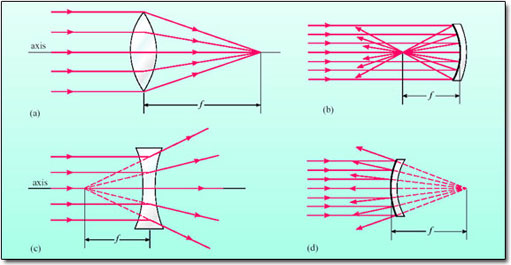Three important focusing properties of spheroidal surfaces are described in the three following statements. Unfortunately, neither of the first two statements is exactly true for any real optics, but they are extremely valuable approximations to the truth and will greatly aid your ability to understand the layouts of optical instruments such as telescopes and spectrographs.
-
When parallel rays of light pass through a lens with convex spheroidal surfaces, or reflect from the surface of a spheroidal concave mirror, they are brought to a focus. The distance of the focal point from the lens (or mirror) is called the focal length, f. This is a single quantity that characterises the optical performance of the lens or mirror in question.
-
Light rays passing through the centre of a lens do not deviate from their original path.
-
Light paths do not depend on the direction in which light is travelling. So, for example, since parallel rays of light are brought to a focus by a convex lens at a distance f from the lens, then rays of light emanating from a point a distance f away from the lens will be converted into a parallel beam. A lens which is used in such a way is called a collimator, and the beam of parallel light that is produced is said to be collimated.
Broadly speaking there are two sorts of lenses and mirrors used in optical systems. Converging (convex) lenses and converging (concave) mirrors each cause parallel rays of light to come together at the focal point, or focus, of the lens or mirror as shown below. In contrast, diverging (concave) lenses and diverging (convex) mirrors each cause parallel rays of light to spread out as if emanating from the focal point situated at a distance of one focal length from the centre of the lens or mirror concerned.

(a) A convex lens will cause parallel rays of light to converge to the focal point. (b) A concave mirror will cause parallel rays of light to converge to the focal point. (c) A concave lens will cause parallel rays to diverge as if from the focal point. (d) A convex mirror will cause parallel rays to diverge as if from the focal point. The reflecting surface of the mirror is shown by a thicker black line

Rate and Review
Rate this article
Review this article
Log into OpenLearn to leave reviews and join in the conversation.
Article reviews